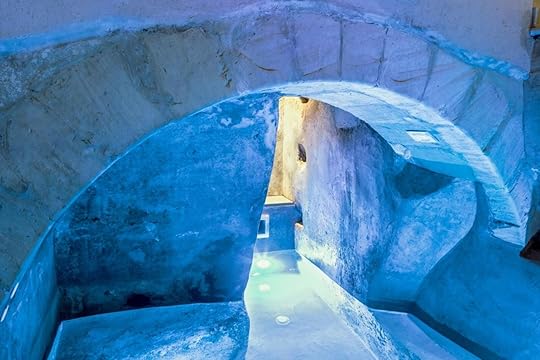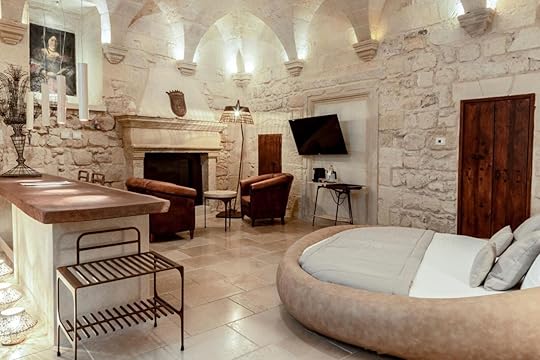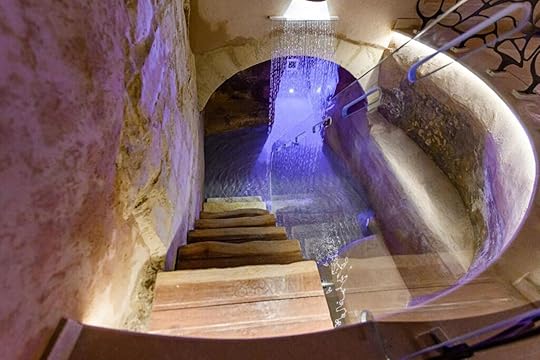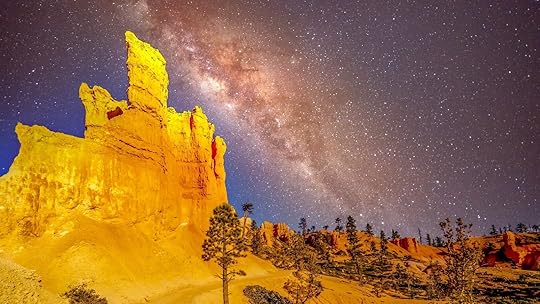Matador Network's Blog, page 365
January 11, 2023
In the Heart of Mendocino National Forest This Airbnb Has an Outdoor Redwood Shower

On the northern coast of California is the idyllic town of Mendocino. Framed by a dramatic coastline of rugged cliffs and rocky shores, this charming area of the state is also home to Mendocino National Forest. The dense forests of towering redwoods and winding trails make for an excellent destination for outdoor enthusiasts. It’s also a superb place to camp. The grounds have many developed campsites and facilities you can set up with your gear. But if you’d rather glamp, then have a look at this irresistible Mendocino National Forest Airbnb tent cabin that comes with an outdoor redwood shower.
We hope you love the Mendocino National Forest Airbnb we recommend. Just so you know, Matador may collect a small commission from the links on this page if you decide to book a stay. Listed prices are accurate as of the time of publication.
@epic.stays This #airbnb has an outdoor #redwood showerFind it linked in my bio
Heartwood Mendocino in #California
IG: @heartwood_mendocino #airbnbfinds #uniqueairbnb ♬ Chiquitita x Twilight – twibytez
The private tent cabin comfortably sleeps two guests and comes with a queen-sized bed, luxury linens, a comforter, and rich warm textiles. Other glamping essentials such as lanterns and towels are also provided.

Photo: Airbnb
If visiting during the winter months, you don’t need to worry about being cold. The nearby bathhouse and common room are heated and have indoor showers. However, this Airbnb is famed for its outdoor redwood shower, which guests can enjoy year-round.

Photo: Airbnb
Cooking facilities do not disappoint either. The outdoor shared kitchen has superb barbeques, sinks, refrigerators, and dining tables.

Photo: Airbnb
The cabin tent costs an average of $165 per night with a minimum stay of two nights.
Activities in Mendocino National ForestThe Mendocino National Forest is a great place to explore and enjoy the outdoors. Here are some fun activities you can do in the forest.
Hike along scenic trails, winding through vibrant meadows and towering redwoods.Go fishing for bass, trout, or catfish in pristine lakes.Take part in a ranger-led nature walk and learn about local flora and fauna.Cycle along wide paths with beautiful views of mountains and valleys.Observe wildlife such as bald eagles, ospreys, deer, and elk. Swim in refreshing lakes or go rafting along river rapids.Take part in birdwatching, photography, or simply relax by the campfire. More like thisNational ParksCalifornia Said To Stay Close To Home, and That Turned Out To Be a Great Thing
More like thisNational ParksCalifornia Said To Stay Close To Home, and That Turned Out To Be a Great Thing
The Best Sites To Visit on Your Next Trip To Yosemite National Park

Yosemite National Park is a popular destination for visitors not just from the US, but all over the world. This stunning park covers nearly 1,200 square miles of pristine wilderness with an incredible variety of activities to enjoy. From mountain biking and hiking to stargazing, there are countless spots within Yosemite to put on your bucket list.
@matadornetwork #YosemiteNationalPark in #California is huge, about 1200 square miles to be precise. If you're planning a visit @Shawn | Food & Travel Creator has the four spots you can't miss while you're there#yosemitenp #nationalparks #yosemitecalifornia ♬ original sound – Matador Network
The tallest waterfall in North America is located right here in Yosemite National Park. Yosemite Falls is an impressive 2,425 feet high, making it a popular attraction for visitors. You can view this stunning waterfall from several different viewpoints throughout the park, but the best views are from Yosemite Valley and Glacier Point. From these vantages points you can get an up close look at the powerful flow of water as it cascades down from its source near Half Dome.
Tunnel View is another one of the most iconic spots in Yosemite National Park. Located just past Wawona Tunnel on Highway 41, Tunnel View offers a spectacular view of El Capitan, Bridalveil Fall, and Half Dome from a single viewpoint. This picturesque spot has been photographed thousands of times over by both professional and amateur photographers alike. Whether you want to take some amazing photographs or just sit back and take in the beauty of nature, Tunnel View is definitely worth checking out during your stay at Yosemite National Park.
Mirror Lake is one of many beautiful lakes within Yosemite that is fed by Tenaya Creek. This lake has crystal clear water with reflections so sharp that they look like mirrors on a still day – hence its name! It’s also great for swimming if it’s hot outside, as well as canoeing or kayaking if you want to get out on the water without having to go too far from shore.
One of the most iconic hikes in the world is also located in Yosemite. The Mist Trail to Vernal and Nevada Falls offers breathtaking views, a challenging climb, and an unforgettable experience. The trail takes hikers on a three-mile round trip from Happy Isles to either Vernal Fall or Nevada Fall. A loop trail can be made by taking the John Muir trail back down to Happy Isles, adding an additional three miles to your trip.
These Vietnamese Rowers Show Off the Remarkable Way They Row Their Boats

Vietnam is a country with a rich and diverse boating culture. From the bustling cities along the coast to the tranquil rivers flowing through the country’s heart, boats have long been an essential part of daily life in Vietnam. One of the most notable aspects of this boating culture is the traditional technique of “leg rowing” used by many of the country’s boatmen.
@matadornetwork The Vietnamese know what's up

@wheretofindme #vietnamtravel #travellife #boattok #rowing ♬ My Girl Wukileak – wüki
Leg rowing is a technique that involves using the rower’s legs as the primary source of power rather than their arms. The rower sits with their legs extended and pushes against a footrest with their feet to propel the boat forward. This method is unique to Southeast Asian cultures and is said to be less strenuous than traditional arm rowing, allowing for long hours of rowing on the river.
The use of leg rowing for boats in Vietnam is likely due to a combination of historical and practical factors. One reason is that the rivers and coastlines in Vietnam have strong currents and often choppy waters, which can make traditional arm rowing difficult. Using the legs as the primary power source allows for more stability and control in these conditions while also providing more power. Additionally, this method is more efficient for fishermen to navigate the river and sea for a more extended period to catch fish.
This traditional technique of leg rowing is not only practical but also deeply rooted in the culture and history of Vietnam. Many local fishermen have learned this rowing method from their ancestors and continue to pass it down to the next generation. The technique is also often showcased in traditional festivals and ceremonies, where boatmen demonstrate their skill and strength during leg rowing.
In recent years, many traditional boats in Vietnam have been replaced by motorized vessels, but the tradition of leg rowing has remained. Many local fishermen continue to use the traditional leg-rowing technique on their boats, keeping this unique aspect of Vietnam’s boating culture alive.
Overall, the Vietnamese leg-rowing technique is a unique and fascinating aspect of the country’s boating culture and a practical and efficient way of navigating the rivers and sea that have shaped Vietnam’s history and culture. It’s a tradition that deserves to be celebrated and preserved. 
How To Spend a Luxurious Weekend in Saint-Tropez

The French Riviera is a popular destination for travelers looking to indulge in some of the most beautiful landscape and culture that Europe has to offer. One of the best spots on the Côte d’Azur is Saint-Tropez, which offers a unique combination of chic beach vibes, breathtaking views, and plenty of activities to keep your days full.
@matadornetwork If you're looking for a luxurious vacation destination @Kayla Chance will show you why Saint-Tropez on the French Riviera might be the perfect spot for you#sttropez #SaintTropez #sttropezlifestyle #tiktoktravel ♬ original sound – Matador Network
One of the best ways to explore Saint-Tropez is by taking a leisurely stroll through its city center. Here, you’ll find a mix of boutique shops, art galleries and restaurants that will make your day trip truly memorable. Place des Lices is one of Saint-Tropez’s most famous landmarks. Every Wednesday and Saturday morning, locals gather around this picturesque square for their weekly market, where they sell everything from fresh produce to handmade crafts and clothing. It’s a great place for visitors to experience true French culture and buy unique souvenirs. You can also catch local musicians playing live music during these markets.
The beaches in Saint-Tropez are some of the most beautiful in France—and even all of Europe. Whether you’re looking for white sand beaches with crystal clear waters or rocky coves with hidden gems, there’s something for everyone here. Many even offer bars and restaurants along the shoreline so you can enjoy drinks and snacks while taking in the stunning views of the Mediterranean.
If you’re looking for a bit more action than lounging on the beach, then you won’t be disappointed by what Saint-Tropez has to offer. From museums and galleries to clubs and bars, there’s no shortage of cultural attractions and nightlife experiences in this city. The pedestrian streets in town are lined with boutique stores selling designer fashions as well as local craftsmen selling handmade items. There are also many vibrant cafes where you can sit back and enjoy a delicious meal or sip on a glass of wine while watching life pass by. For those who love art, there are several galleries showcasing works from local artists as well as world-renowned masters such as Picasso, Matisse, Monet, Renoir, Cezanne, Van Gogh and more. There are also several theaters that host plays throughout the year if you’re keen on taking in some live entertainment during your stay. After dark is when things really start heating up – there’s plenty of bars, clubs and music venues offering exciting nightlife experiences until late into the night.
Explore the Best of Fort Myers — From the Beach To the Nature.

Fort Myers, Florida, is the gateway to the Gulf of Mexico and an excellent destination for sun and sand. This coastal city is full of things to do, from outdoor activities like hikes and bikes, to cultural attractions, and there are plenty of great places to stay. Whether you’re a beach lover or an adventurer, there’s something for everyone in Fort Myers.
Shelling at cayo costa state parkCayo Costa State Park is located on Cayo Costa Island, off Florida’s Gulf coast. It is known for its beaches and shelling opportunities. Visitors to the park can find a variety of shells washed up on the shores, including scallop, conch, and whelk shells. Some of the shells may be inhabited by living creatures like hermit crabs, so it is essential to handle them carefully and return those animals to the beach if found. Beachcombing is a popular activity among visitors to the park, and it’s an excellent opportunity to see some unique shells or other natural treasures.
Jet skiing at Captiva islandAnother popular destination is Captiva Island. This island is great for jet skiing, as it offers clear, calm waters and various sights to see. Even first-timers can enjoy riding the waves, exploring the coast, and even jumping the waves. Jet ski rentals typically include the jet ski, safety equipment, and instructions on how to operate the machine. Be sure to check local laws, regulations and restrictions before jet skiing and always wear a lifejacket. And be sure to follow the guidelines of the rental company and respect the other boats and people on the water.
Nature walkthrough at Corkscrew Swamp SanctuaryCorkscrew Swamp Sanctuary is a nature reserve that’s home to a wide variety of plants and animals, including the endangered Florida panther. The sanctuary’s main attraction is the 2.25-mile boardwalk that winds through the swamp, allowing visitors to see various wildlife and vegetation in their natural habitats. The path is a raised walkway that allows visitors to walk above the swamp, providing a unique perspective on the plants and animals. During a nature walk through the sanctuary, visitors can expect to see a wide variety of birds, such as wood storks, herons, egrets, and ibis, and other animals, such as alligators, otters, and marsh rabbits. The swamp is also home to various trees and plants, including the rare and endangered ghost orchid. Visitors should wear comfortable shoes and be aware of their surroundings.
Shopping around Fort Myers pierFort Myers Beach, specifically the area around the Fort Myers Pier, offers a variety of shopping options for visitors. Many small shops sell souvenirs, beachwear, and other tourist items along the beach. The area also has a few local art galleries; you can find local paintings, sculptures, and other artwork for sale.
Fort Myers is a destination that’s full of adventure. Consider skipping Miami and checking out this underrated beach town instead. 
This Couple Flew Their Two Dogs To Paris on a $100,000 Private Jet

For some people, there’s no end to what they’d do for their dogs. And when one of your dogs is a 150-pound mastiff who is too big to fly in cargo on planes, well, there’s only one thing to do when you need to relocate them to Paris, France: charter them a private jet.
@herboozytails Cost + all over videos are in our “moving abroad with dogs” playlist! Honestly so grateful for this experience but even more grateful that it’s all over withwe didn’t love having to pay this much to get the dogs over, nor the stress of planning the flight, but it was all worth it for the rest of our experiences! #movingabroad #traveldog #dogmom #traveltok #greatdane ♬ How`s Your Day – aAp Vision
When the couple decided to relocate to Paris, that meant their three dogs were coming along, too. However, they didn’t want their senior golden retriever and 150-pound great dane age to fly in cargo. They felt their golden was too old to be comfortable on a long flight, and since their great dane is so big, he exceeded the maximum weight specs for most airline cargo compartments. So they did what any loving pet parents would do and found an alternate way to fly with the dogs.

Photo: TikTok/HerBoozyTails
For the two pups, plus one of their human parents, the cost was around $12,000. However, because a private plane charter to France from New York costs far more than that, they reached out to other pet parents around the country to split the cost with other families relocating with dogs. The final manifest on the plane included nine humans and 11 of the luckiest dogs in the world. The couple decided to have their smaller dog, around 12 pounds, fly commercial (with one of his humans, of course).
The dogs on the flight had a great time
Photo: TikTok/HerBoozyTails
In the adorable video, it’s clear that the owners all went out of their way to make the dogs comfortable. Like most humans presented with the opportunity to travel via private plane, the dogs took advantage of their flights by getting as comfortable as possible. From curling up in the oversized leather armchairs to stretching out a bit and using the armrests as chinrests, it seems like every dog had a great time. And considering they had humans available to ensure they had plenty of cozy blankets and ear scratches on demand, the dog’s flights were more comfortable than the humans.
The humans…not as muchView this post on Instagram
A post shared by Melanie | Travel & Lifestyle Creator
(@herboozytails)
While the plane itself was certainly luxurious, the humans didn’t get much sleep. According to Melanie Demi in the video, “Rather than relaxing, it was mostly about just trying to keep the dog as calm as possible.” While it looks like all the dogs got some shuteye, most of the humans stayed awake for the entire eight-hour flight to ensure their furry friends didn’t have any problems or get scared during the flights.
How to find a plane that allows dogs on flights
Photo: OlgaOvcharenko/Shutterstock
In order to fly their two pups to Paris without going broke, the couple started by trying to find other people with dogs moving to Europe. By booking one shared flight, they were able to split the total cost of just over $100,000 with eight other travelers. That brought the cost per person (not per dog) to a “reasonable” $12,000. A large fee for sure, but certainly worth the sacrifice for humans who would never consider putting their pubs in the cargo hold of planes. The couples said it took three years of planning and saving to make the trip happen.
It’s easy to find online private jets available for charters, and prices carry based on factors like the type of aircraft, flight distance and length, and the time of year. But in general, the cost of a private jet charter can range from a few thousand dollars for a short, domestic flight to tens of thousands of dollars for an international flight. Websites like PrivateFly and JetSuite can usually provide nearly immediate quotes.
No word on any extra fees for carrying not one but 11 four-legged friends was, but one clear thing is that it must have been the cutest flight landing in Europe that day. As one TikTik commenter responded, “I would actually pay more to be on a private plane with 19 dogs.”Considering how many airports have therapy dog programs, there are probably quite a few people out there who share the same view.
Airline pet regulations on US airlines
Photo: nadisja/Shutterstock
Regulations vary a bit airline to airline for dogs on flights, but they’re all fairly similar.
American, Delta, Southwest, and United all allow cats and small dogs on flights in the cabin on most flights within the U.S., Puerto Rico, and the U.S. Virgin Islands, but there are some restrictions on flights to other destinations. Fees start at $125 each way for America, Delta, and United, and $95 each way on Southwest.
However, some countries won’t let you enter with pets in the cabin, such as Australia, Japan, New Zealand, and the UAE, all of which only allow pets in cargo to enter the country. However, traveling with pets in the cargo areas of planes can be dangerous, and also limited by your pet’s size. On most US airlines, the combined weight of your pet and his or her carrier can’t exceed 100 pounds.

Photo: Jaromir Chalabala/Shutterstocks
Additionally, most vets recommend against traveling with your pet in cargo whenever possible. Traveling in cargo can be extremely scary and stressful, and temperatures can vary wildly during the flight, as can how well your pet is secured during turbulence. The max time a dog is allowed to be in cargo as well is usually around seven or eight hours, which means you’ll need to book a multi-stop flight to give your dog a chance to get out of his or her crate.
What all this means is that private air travel may be the only option for folks who treat their dogs like family or who have dogs larger than 90 or so pounds. Additionally, don’t forget that many countries have strict requirements about bringing in domestic pets, ranging from proof of a vaccine certificate to letters from vets, passports, and mandatory quarantine time. You can check those regulations at BringFido.com.
International travel can be hard on even the most gentle-natured of pets, so if you have the means to do so, booking a private (and adorable) group flight may be your best option. 
Kazakhstan’s Tohax Bread Is a Treat for the Eyes and the Stomach

Bread is a staple in just about every country around the world. France has its baguette, Iceland has its Laufabrauð, Germany has its Pumpernickel loaf, and Kazakhstan’s got its tohax. This Kazakh bread both looks pretty and tastes delicious.
@foodwtf #Tohax is a traditional bread from #Kazakhstan , it's cooked inside a clay oven called a tandoor
IG: @biscuit.qaz #foodie #foodtiktok #foodtravel #Kazakhstanfood #flatbread ♬ Lofi – Domknowz
Tohax are round and flat breads, but unlike South Asian naans or Middle-Eastern pitas, two of the most famous flat breads in the world, they are thick and sturdy instead of soft and pliable.
The recipe for making tohax dough is very simple: flour, water, milk, yeast, salt, sugar, and butter. Before going in the oven, the raw bread also gets a wash of milk and egg to make its exterior appearance golden and shiny.
Each tohax is decorated, either with a stamp (known as chekich) pressed in its dipped centre, or a light pattern is scored using a kitchen utensil like a fork or a knife, making for a beautiful result. No two bakers make the same tohax so, decorations, including patterned edges, and recipes, can vary according to regions or preferences.
Tohax are baked in a traditional clay oven known in Central Asia as a tandyr oven. The baker applies the raw and tacky Kazakh breads onto a rounded handheld utensil and extends their arm in the extremely hot oven to stick them straight onto the clay where they will bake for about 20 minutes. When ready to come out of the oven, the tohax are collected individually by a deep and circular bread peel or a metal rod with a hooked end.
While tohax is the Kazakh name for this bread, it is found throughout Central Asia, including in Uzbekistan, Kyrgyzstan, and Tajikistan under the name of tandyr nan, or lepyoshka. 
At This South African Safari Lodge You Can Take Breakfast With Elephants

Imagine waking in one of the most spectacular game parks, Kruger National Park, in South Africa to a herd of elephants outside your terrace. This is the view guests at Sabi Sabi Earth Lodge are welcomed with. At this world-renowned luxury safari lodge, you don’t need to go far to view some of Africa’s Big Five.
@epic.stays Imagine waking up to a heard of elephants outside your doorstep
Sabi Sabi Earth Lodge in #Mpumalanga #SouthAfrica
@olweV2 #traveltok #elephants #safarilodge #travelafrica #africahotelguide ♬ original sound – sl0w sl0w
About Sabi Sabi Earth Lodge
The lodge is located in the Greater Kruger Park in South Africa. It’s nestled between two hills and overlooks an open savannah plain. As one of South Africa’s most renowned and luxurious private game reserves, Sabi Sabi offers a unique and unforgettable safari experience with exceptional wildlife sightings, guided activities, and authentic African hospitality.
Suites at Earth LodgeHome to 13 ultra-luxurious suites, the lodge is ideal for those seeking a once-in-a-lifetime safari experience. Each unique build has spectacular views of the African bush, elegantly designed interiors, and all the luxuries one could expect from a five-star lodge.
Huge windows look out onto a private terrace with a plunge pool. It’s here that guests rave about enjoying a delicious breakfast with the backdrop of a herd of elephants grazing at the nearby waterhole.
What to do at Sabi Sabi Earth LodgeSafari is, of course, the main reason people stay with the Sabi Sabi group. The safari tours are world-renowned. Each morning and evening guests depart from the luxury lodge into the wilderness either on foot or in a vehicle with a knowledgeable game ranger and Shangaan tracker.
Between safari, the Sabi Sabi complex is home to a huge amount of amenities from a kitted-out gym, a world-class spa, an art gallery, an underground wine cellar, and a library. 
Hidden Down Secret Stairs This 16-Century Italian Suite Has an Underground Cave Pool

In Lecce, a city in the region of Apulia, in southern Italy, a 16th-century palace-turned-hotel has one of the most unique suites we’ve ever seen. Pollicastro Boutique Hotel’s Grand Deluxe Nymphaeum Suite holds a secret. Narrow stairs lead guests underground into the bathroom cave that overlooks a sunken swimming pool.
We hope you love Pollicastro Boutique Hotel. Just so you know, Matador may collect a small commission from the links on this page if you decide to book a stay.
@epic.stays This is the Grand Deluxe Nymphaeum Suite With Underground Cave Pool at thePollicastro Boutique Hotel in #Lecce #Italy
@LUANA&FRED | TRAVEL •LIFESTYLE #italytravel #traveltiktok #traveltok #itaalyhotelguide #luxuryhotels ♬ How deep is your love – tommasoreplica
The city of Lecce is known for its Baroque architecture and historic monuments. It was founded by the Romans in the third century BC and later became a significant hub during the Middle Ages. Despite being relatively small, it is considered one of the most interesting and beautiful cities in Italy. Lecce has undergone a huge amount of restoration. The majority of ancient buildings and streets are very well preserved. As is the Pollicastro Boutique Hotel.
About Pollicastro Boutique HotelThroughout its existence, this elegant and refined hotel has been lovingly restored and maintained, preserving its traditional charm while adding all the necessary modern comforts. Today, the restored palace stands proud as a symbol of old-world Italian luxury — with stunning original frescoes adorning its walls and spacious light-filled rooms looking out over the surrounding cityscape.
The Grand Deluxe Nymphaeum Suite at Pollicastro Boutique Hotel
Photo: Booking.com
Located on the hotel’s third floor, The Grand Deluxe Nymphaeum Suite sprawls over two levels. It retains original 16-century stonework and artwork on the walls and ceiling. The elegant living area looks out over the city and the plush king-sized bed, adorned with Italian linens frames the room.

Photo: Booking.com
Down a narrow stone-clad staircase is the underground bathroom. It’s here where guests are welcomed by a huge rainshower, twin sinks, and their own private cave swimming pool. Adorned in blue lights, the sunken pool has a comfortable sitting area where guests can relax in the calming aqua haze.
Dining at Pollicastro Boutique Hotel
Photo: Booking.com
The on-site restaurant offers a wide range of traditional Italian cuisine and international dishes including mouthwatering appetizers, homemade pasta, and pizzas cooked in an authentic wood oven. Guests rave about the breakfast buffet which offers a huge selection of local meats, cheeses, homemade bread, and preserves.
What to do near Pollicastro Boutique HotelFrom exploring Lecce’s historical walls and monuments to discovering local cuisine or shopping at Lecce’s characteristic boutiques, Pollicastro Boutique Hotel is an ideal base for exploring the ancient city. Here are a few of the must-see attractions.
Explore the historical center of Lecce and marvel at its Baroque architecture.Take a stroll through Piazza Sant’Oronzo, the main square of the city lined with 16th-century buildings and statues.Admire artwork inside Cathedral di Lecce.Enjoy some delicious regional food such as ciceri e tria pasta and the traditional Italian savory treat Rustico.Relax in one of many beautiful gardens.Enjoy an afternoon at Lecce’s flea markets and antique shops. More like thisDessertThis Pastry Shop in Naples Makes the Most Chocolaty Pancakes You’ll Ever Taste
More like thisDessertThis Pastry Shop in Naples Makes the Most Chocolaty Pancakes You’ll Ever Taste
January 10, 2023
This National Monument Offers Amazing Stargazing Views

Have you ever dreamt of spending an evening stargazing amongst the majestic cliffs of the Vermilion Cliffs National Monument? Located in northern Arizona, this national monument is one of the best places to enjoy a night under the stars. Not only is it a beautiful destination, but it’s also one of the best places in the United States for stargazing.
Vermilion Cliffs National Monument is located in northern Arizona, just south of the Utah border. It has nearly 300,000 acres of stunning red-rock canyons, sandstone cliffs, and desert wilderness. With its unique location away from major cities and towns, it’s one of the darkest spots in the state. Light pollution is virtually non-existent.
@matadornetwork The #VermilionCliffs in #Arizona are a great place to spot the #milkyway
@Benjamin Theurer #astrophotography #starphotography ♬ original sound – Matador Network
On any night, you can expect to see hundreds of stars twinkling above you, along with planets like Venus or Jupiter depending on the season. Additionally, many different types of constellations, comets, and planets are visible here throughout the year – so no matter when you visit, the sky will be filled with plenty of fascinating sights.
Before heading out on your stargazing adventure, plan ahead and bring all necessary supplies and gear. It’s important to dress appropriately for the weather and bring plenty of warm layers – temperatures can drop significantly after sunset in this part of Arizona. Make sure to pack other necessities such as flashlights, binoculars, or telescopes to red lights (to preserve your night vision) and star charts — having all these items handy will make sure your time spent stargazing in The Vermilion Cliffs National Monument goes off without a hitch!
How To Get ThereVermilion Cliffs is about two hours from Flagstaff in northern Arizona. The easiest way to get there is by car – just follow Highway 89 North until you reach Mile Marker 93, where you will turn right onto BLM Road 1030 (also known as House Rock Valley Road). From there, it’s only a short drive until you reach Vermilion Cliffs itself – be sure to enjoy all the incredible scenery along the way.
If you’re looking for an unforgettable experience under a star-filled sky, then Vermilion Cliffs in Arizona is worth considering. With its night skies and remote location free from light pollution, this area offers unparalleled stargazing opportunities–whether observing constellations or spotting distant planets and comets. 
Matador Network's Blog
- Matador Network's profile
- 6 followers






